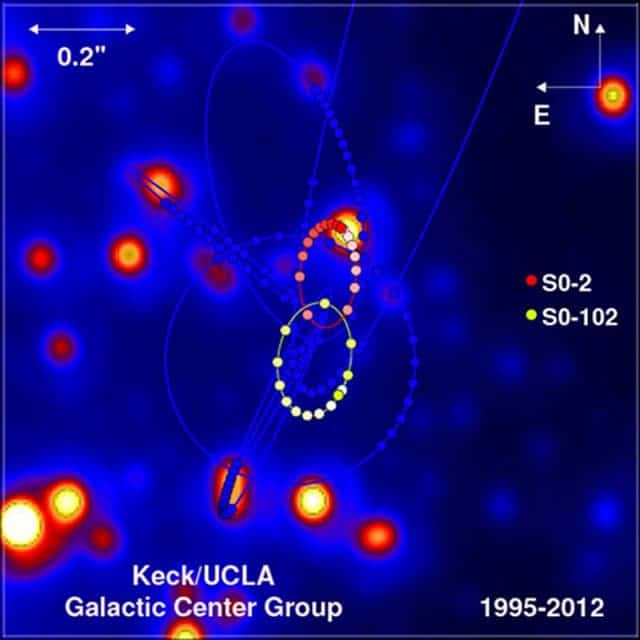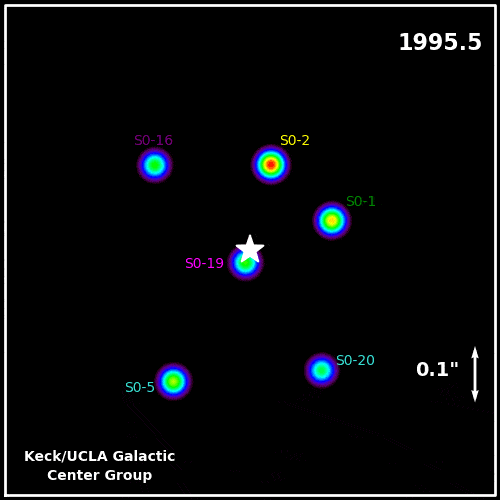Astronomers at UCLA university have made a remarkable discovery, after they’ve confirmed the presence of a star orbiting the black hole at the center of our galaxy in a mere 11-and-a-half years – that’s the shortest known orbit of any star near this black hole. The researchers involved in the paper describing the find claim that data will help test Einstein’s theory of relativity, which predicts space and time are warped around the gravitational field of a black hole.

A high-resolution infrared image of the region surrounding the black hole at the center of our galaxy that shows the two orbits of the closest stars. Other orbits are shown in fainter orbits. (c) UCLA
The center of our galaxy is such a hectic place that direct and accurate optical observations around the black hole are simply impossible. Instead, scientists rely on the data they can gather by reading radio, X-ray and infrared waves. To their aid comes the Keck telescope on Mauna Kea in Hawaii, which has been watching stars near the galactic center in IR for 17 years, providing a detailed view of their dynamics. Using the telescope, astronomers answered some of the most puzzling astronomical questions in recent history, thus we now know:
- at the center of our galaxy, lies a supermassive black hole some 26,000 light years ago, with a mass 4 million times that of our sun.
- stars accelerate around the supermassive black hole. Further research should confirm the trend for the newly found, fastest orbiting star as well.
- in 2005, the telescope took the first clear picture of the center of the Milky Way, including the area surrounding the black hole, using laser guide star adaptive optics technology.
The newly confirmed star, dubbed SO-102, has had its orbit completely mapped, thanks to its short period. This is only the second star to have its orbit completely mapped, after the neighboring S0-2. Data from the two orbits together will help astronomers model the black hole itself, as direct IF observations are restricted due to it being invisible. Much of the merit for achieving these immense milestones in astronomy go to Andrea Ghez, leader of the discovery team and a UCLA professor of physics and astronomy who holds the Lauren B. Leichtman and Arthur E. Levine Chair in Astrophysics. Ghez has 3,000 stars that orbit the black hole, and has been studying S0-2 since 1995.
“I’m extremely pleased to find two stars that orbit our galaxy’s supermassive black hole in much less than a human lifetime,” said Ghez.
“It is the tango of S0-102 and S0-2 that will reveal the true geometry of space and time near a black hole for the first time,” Ghez said. “This measurement cannot be done with one star alone.”

The first star with a sufficiently short orbital period to enable a complete three-dimensional reconstruction of its trajectory, SO-2, has an orbital period of around 16 years, but why did SO-102 take so long for it to be discovered? Well, the main reasons is that it’s very faint – around 16 times less brighter than SO-2. Thus, astronomers used the black hole data from prior observations to determine S0-102’s orbital properties, a feat made possible thanks to the Keck telescope’s novel adaptive optics technology, which allows for the 10-meter-diameter mirror to dynamically adjust in order to correct the distorting effects of the Earth’s atmosphere in real time.
“The Keck Observatory has been the leader in adaptive optics for more than a decade and has enabled us to achieve tremendous progress in correcting the distorting effects of the Earth’s atmosphere with high–angular resolution imaging,” Ghez said. “It’s really exciting to have access to the world’s largest and best telescope. It is why I came to UCLA and why I stay at UCLA.”
Milky Way’s dark core that warps time and space
Over time, Ghez and colleagues’ goals have evolved from demonstrating the existence of a black hole at the center of our galaxy, to validating fundamental laws of physics. At high velocities and gravity, Newtonian physics aren’t enough to explain irregularities in elliptical orbits, such as that of Mercury that has an irregular motion due to the sun’s mass to which it is in very close proximity. Measuring the warping effects of the Milky Way’s black hole on spacetime is a lot easier and evident than observations around the sun or similar stars, since the black hole is 4 million times more massive. Long term observations are required, however, in order to spot general relativistic effects, which are cumulative over multiple orbits.
One way for the scientists to test relativity is to measure the redshift, where the black hole’s gravitational influence stretches the wavelength of light towards the longer end of the electromagnetic spectrum.
“The fact that we can find stars that are so close to the black hole is phenomenal,” said Ghez, who also directs the UCLA Galactic Center Group. “Now it’s a whole new ballgame, in terms of the kinds of experiments we can do to understand how black holes grow over time, the role supermassive black holes play in the center of galaxies, and whether Einstein’s theory of general relativity is valid near a black hole, where this theory has never been tested before. It’s exciting to now have a means to open up this window.“This should not be a neighborhood where stars feel particularly welcome,” she added. “But surprisingly, it seems that black holes are not as hostile to stars as was previously speculated.”
The findings were published in the journal Science.
source: UCLA newsroom









